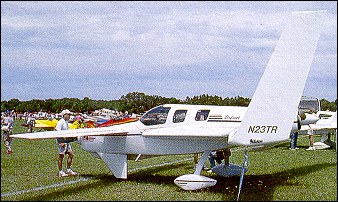|
| The first prototype flew on June 30, 1978. A total of 200 aircraft sets were sold.
 | A three-view drawing (460 x 305) |
| MODEL | Model 74 "Defiant" |
| CREW | 1 |
| PASSENGERS | 4 |
| ENGINE | 1 x Avco Lycoming, 134kg |
| Mark Shinnick, e-mail, 01.04.2023 21:53 Defiant I'd been working with got down to 1780 lbs w / 2 180HP o-360's after a demonstrated 230mph with constant-speed props whose much greater weight too-greatly suppresses its many unique handling, power-to-weight and safety /simplicity /economy advantages. An example sweetspot at 9500 is 175 statute at 10 GPH....it just depends how much fuel flow you care to throw at it for only up to another 32mph speed. I personally found it fairly close to what a Mooney would do fuel economy-wise, but with far superior utility, amazing slow speed handling and overall safety. reply | | Alan, e-mail, 04.07.2013 02:34 i states that it has 1 x Avco lycoming engine. does it not have 2? reply |
| Terrence Murphy, e-mail, 04.09.2012 16:40 In 1975, Burt Rutan applied himself to the problems of building a canard-controlled, centerline thrust twin, and the result was a Star Wars design known as the Defiant. The Rutan RAF-40 (also called the Rutan-Elbert Model 40) was an experimental canard prototype. This POC (proof-of-concept), four-seat, "push-pull" engine, light aircraft of unconventional design, was derived from the experience gained with the previous smaller VariEze.
It retained the rear-mounted swept cantilever wings with winglets, canard fore-plane and the retractable nosewheel /fixed main-wheel type landing gear. The prototype Rutan Model 40 Defiant made its maiden flight from Mojave, California, in June, 1978. The Defiant was then offered as the Model 74 in kit-plane form in mid-1984.
The Defiant is built using fiberglass layup over Styrofoam core shapes in the same manner as the Rutan Vari-Eze. The main gear is fixed and there are no flaps. The Propellers are fixed-pitch non-feathering, which is unusual in a twin-engine design. Cockpit entry is through a side hinged canopy. The winglets serve the primary purpose of providing yaw stability, and secondary purpose of reducing wing vortices.
Crew: 1
Capacity: 3
Wingspan: 30 ft 9 in
Wing area: 139.4 sq ft²
Length: 22 ft 8 in
Height: 9 ft 3 in
Empty weight: 1,701 lbs
Loaded weight: 2,997 lbs
Max. takeoff weight: 2,997 lb
Powerplant: 2 × 160 hp Lycoming O-320 engines
Maximum speed: 216 mph
Range: 1,130 miles reply | | Richard L Mac Arthur, e-mail, 14.05.2008 21:20 it's one of the best twin engine aircraft ever designed
-former owner reply |
|
Do you have any comments?
|
| 
COMPANY
PROFILE
All the World's Rotorcraft
|












Yes, designed as a twin. Use of Ford v-6's in one of these didn't work out so they were replaced with Lycomings. The O-360 may be the overall best for it.
The real key to make this airplane work the very best is in keeping things as simple, bulletproof and as light as possible, which purpose-designed aircraft engines generally do.
reply